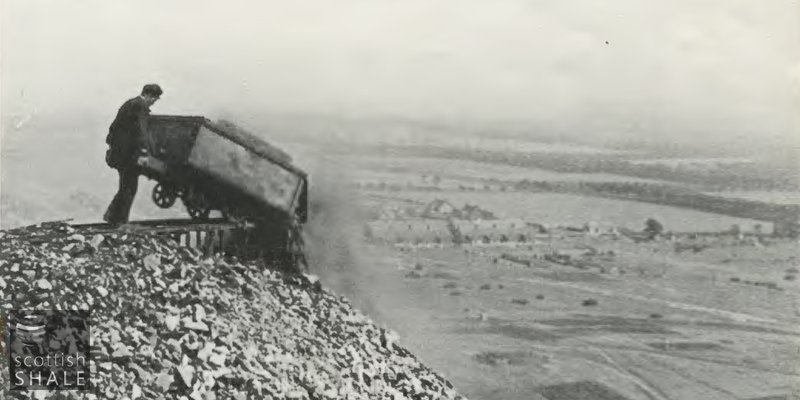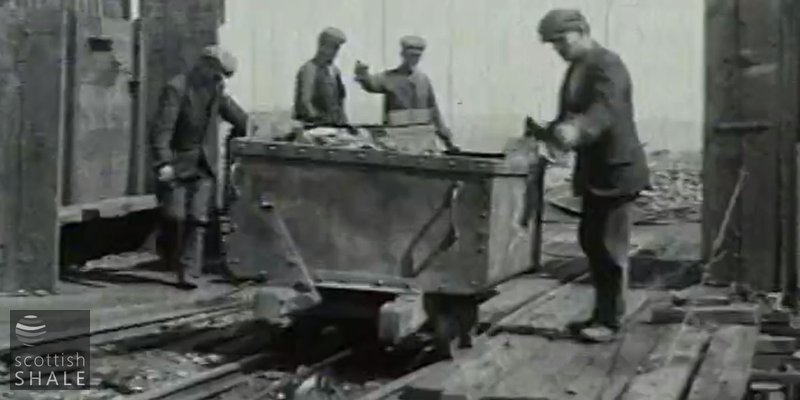Tipman
also known as Tip Head Man, Tipper, Tip Labourer, Tip Attendant

See full file: LVSAV2009.029.011 Tip man tipping spent shale onto a spent shale bing, circa 1929

Frame grab from the film "The Scottish Shale Industry" 1929.
Associated occupations: Tip roadsman
A tip man was employed at the oil works to tip hutches of spent shale from the retorts onto the waste tip or "bing" that could reach heights of up to 200 feet.
The job of a tip man was a dangerous one: as well as the risk of being badly burned from the roasting hot shale that had come straight from the retorts there was the risk of falling or being pulled from the top of the bing by the heavy hutches of shale that the men had to tip out.
Wages & Working Hours
The average weekly wage of a tip man in 1886 (Board of Trade Census of Wages) was 26s 8d. The report states that men working in crude oil works worked a 13 day fortnight with the majority of tip men working between 54.5 and 63 hours per week.
In 1958, an Agreement Between the Scottish Shale Oil Companies and the National Union of Shale Miners & Oil Workers records that tip men earned between 30s 7d and 31s 8 d per shift. Tip labourers earned 30s 7d per shift. Tip workers worked a three shift system consisting of a 6 day week of 48 hours.
Snippets
"The jobs in the oil works and on the bings were generally less skilled than mining. Possibly one of the worst jobs was on top of the bings emptying the spent shale...." IOM Historical Research Report TM/90/02, 1990
"I started on the retorts with a wage of about 8 a week (1950) and if you worked up the tip you got the biggest wage, so I decided to have a go at the tip, which in the winter was a very hard job and a dangerous job as well, because there was always a chance of you getting blown over. The rails at the head of the tip they were white hot, and you used to have an old cap on and an old piece of duster tucked in, so you bent forward and you lifted the hutch at the same time so that the stuff went down the tip." IOM Historical Research Report TM/90/02, 1990
"You see these great big red bings that you see about this district, burnt shale.......There was a chain or steel rope that took the wagon loads of burnt shale up and the the chain run on to a high thing and the hutch went off the shale and the man got it there and had some trek away along the bing somewhere ...The tip man had a great lump of cotton waste in the front of his cap and he got the two trams and his head against it and up and you heave it emptied it and took it back. They were issued with oil skins and sou'westers but it didn't matter what kind of night it was it was 24 hours a day because these retorts couldn't stop". IOM Historical Research Report TM/90/02, 1990
"There is a great bing as you come out opposite the cemetery (Addiewell), well it was almost twice as high and my husband worked up there until they closed the works. You see they brought the shale from the mine and there was some process through the retorts and then the waste was put up this tip. And they used to go out, two's of ten, and then on a Saturday they worked from one right on to five o'clock on a Saturday morning, Sunday morning, that was when they changed over from day shift to back shift. But it was wild going right on the top of the tip". LK, Addiewell
Additional Resources
- Oral history transcript: Mr Ellis & Mr Ellis